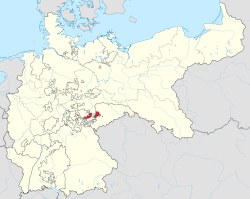
Back دوقية ساكسونيا ألتنبورغ Arabic Саксония-Алтенбург Bulgarian Sachsen-Altenburg Breton Sasko-altenburské vévodství Czech Hertugdømmet Sachsen-Altenburg Danish Herzogtum Sachsen-Altenburg German Saksio-Altenburg Esperanto Ducado de Sajonia-Altemburgo Spanish Saksi-Altenburgi hertsogiriik Estonian Saxonia-Altenburgoko Dukerria Basque
Duchy of Saxe-Altenburg (1602–1918) Herzogtum Sachsen-Altenburg Free State of Saxe-Altenburg (1918–1920) Freistaat Sachsen-Altenburg | |||||||||
|---|---|---|---|---|---|---|---|---|---|
| 1602–1672 1826–1920 | |||||||||
Flag[1]
| |||||||||
 Saxe-Altenburg within the German Empire  The Ernestine duchies after 1825, with Saxe-Altenburg in orange | |||||||||
| Status | State of the Holy Roman Empire, State of the German Confederation, State of the North German Confederation, State of the German Empire, State of the Weimar Republic | ||||||||
| Capital | Altenburg | ||||||||
| Government | Duchy (1602–1918) Republic (1918–1920) | ||||||||
| Duke | |||||||||
• 1603–1613 | Johann Philipp (first) | ||||||||
• 1908–1918 | Ernst II (last) | ||||||||
| History | |||||||||
• Saxe-Weimar partitioned | 7 July 1602 | ||||||||
• Personal union with Saxe-Gotha* | 1672–1825 | ||||||||
• Ernestine duchies rearranged, duchy restored | 12 November 1826 | ||||||||
| November 1918 | |||||||||
• Merger of Thuringia‡ | 1920 | ||||||||
| |||||||||
| Today part of | Germany | ||||||||
* See Saxe-Gotha-Altenburg † As Free State of Saxe-Altenburg ‡ In 1920, the ex-Imperial states of Saxe-Altenburg, Saxe-Meiningen, Saxe-Coburg-Gotha, Saxe-Weimar-Eisenach, Schwarzburg-Sondershausen, Schwarzburg-Rudolstadt and the two principalities of Reuß all merged to form the Free State of Thuringia. | |||||||||
Saxe-Altenburg (German: Sachsen-Altenburg) was one of the Saxon duchies held by the Ernestine branch of the House of Wettin in present-day Thuringia.[2] It was one of the smallest of the German states with an area of 1323 square kilometers and a population of 207,000 (1905) of whom about one fifth resided in the capital, Altenburg. The territory of the duchy consisted of two non-contiguous territories separated by land belonging to the Principality of Reuss-Gera. Its economy was based on agriculture, forestry, and small industry. The state had a constitutional monarchical form of government with a parliament composed of thirty members chosen by male taxpayers over 25 years of age.
- ^ Thüringisches Staatsarchiv Altenburg (Hrsg.): Rautenkranz und rote Rose: Die Hoheitszeichen des Herzogtums und des Freistaates Sachsen Altenburg. Sax-Verlag, Altenburg, 2010.
- ^ "The Ernestine Line's Saxon Duchies" (Web). Historical Atlas. Tacitus Historical Atlas. Retrieved 2007-05-19.
© MMXXIII Rich X Search. We shall prevail. All rights reserved. Rich X Search

